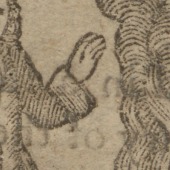A full and particular account of the trial of Robert Folkes and Levi Ladds, for violently assaulting Elizabeth Heythorpe, and committing a capital felony: tried before Chief Justice Storks, at the Isle of Ely Assizes held at Wisbech, March 30th, 1832
Wisbech: Walker, printer, [1832?]
Although Robert Folkes was found guilty of rape at this trial, and his execution was set for 21st April, as soon as the trial was over doubts were expressed as to the legality of his sentence. A petition was submitted to the Chief Justice by Folkes’ defence solicitor, signed by over a hundred of Folkes’ neighbours and colleagues. In May a judge’s investigation of the case recommended a reprieve and a pardon was sent to him on 10th July.
Why was the conviction overturned? This broadside account is rather abbreviated and therefore confusing but it is clear that the evidence given at the trial was equally contradictory and confusing. The Times report of April 3 1832 describes the incident as “incredible” and raised several questions. Why did nobody come to Elizabeth Heythorpe’s rescue, for the crime took place in the centre of the village within shouting distance of dozens of homes? Why did her husband not report the crime earlier? He claimed that he called the Constable (who failed to intervene), but the Constable was not called as a witness. Heythorpe’s husband made no other attempt to report the crime, saying that he himself was incapable of doing so because of injuries received during the initial attack in the street.
Despite the confused state of the evidence, Folkes was condemned. The Times subsequently reported that “Other very important contradictions to the evidence … are said to have been discovered since the trial.” Documents in the National Archive tell the rest of the story: it emerged that Elizabeth was in fact an unmarried woman with previous convictions for “felony and immoral conduct”, who had accepted £5 from Folkes. Her evidence was therefore suspect, and the matter was further complicated by her death in May (apparently from natural causes).
The reference to ‘bankers’ in the broadside account describes labourers who worked on the construction of earth banks and flood defences in the Fenland area.
For more information see the collection of documents relating to the case in the National Archive (Home Office Criminal petitions series 1, reference HO 17/17/46)
Broadsides.B.83.2
Not on display in physical exhibition








